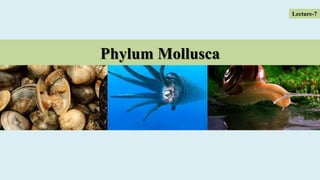
Lecture 7 ( phylum mollusca) ... ppt
- 2. General Characteristics • 50,000 or more species of molluscs. • Bilateral symmetry. • Body enclosed by a blanket-like mantle that secretes a shell made of calcium or some other stiff structure. • A mantle cavity between the mantle and the internal organs; the anus, reproductive, and excretory ducts open into the mantle cavity. • A ventral, muscular foot that is highly modified among the various groups of molluscs. • Head withy sensory organs and a mouth. • Aquatic mollusks have gills. Terrestrial mollusks have lungs. • Herbivorous or carnivorous. All of them with a complex digestive system. • Most of them are hermaphrodites. • In separate sexes individuals, there is no sexual dimorphism. • Most of them lay eggs from which a larvae emerges. It will go under metamorphosis. • Have a true heart • Simple to complex nervous system
- 3. Body Plan
- 4. Body Plan
- 5. Habitat and niche Some molluscs habitats include: • Marine (mostly) • Freshwater (a few) • Land (a few) Molluscs niches (life-style): • Most live on the ocean bottom and are mostly sedentary • Some are free-swimming (the cephalopods)
- 6. Reproduction Sexual • Most are dioecious, • some hermaphrodites (gastropods) • Internal or external fertilization • Fertilized egg develops into trochophore larva: • Free swimming, planktonic larva that feeds on tiny plants. Asexual • Some regeneration
- 7. Ecological Roles Molluscs fill a wide variety of ecological niches • Predators, • Filter feeders, • Food source • Break down decaying plant matter • Filter feeding bivalves can be an indicator of water quality • Shipworms (not worms) burrow through wood boats and docks • Terrestrial molluscs are agricultural pests
- 8. Classes of Molluscs Class Gastropoda • Most popular class of molluscs. • Consists of snails and snail-like creatures. Specific characteristics: • have a dorsally located shell (often coiled). • They have a well-developed radula. • 4 tentacles (2 optic and 2 sensory) • Visceral mass (organs) almost always located inside the shell. Their visceral mass is rotated 180 degrees during development. • They are herbivores or predatory (carnivorous). • Habitats include: ocean, lake, river bottoms, coastal shores, and land. Terrestrial have lungs and aquatic have gills.
- 10. Class Bivalvia • They have no head. • They have two shells held together by powerful muscles. • They have a ventrally located foot that sticks out between the two valves. • They tend to burrow into soft mud or sand or attach to rocks or other shells. • Habitats include marine and freshwater. • Large gills are used for respiration and filter feeding. • Water enters and exits through siphons. Classes of Molluscs
- 11. Classes of Molluscs Class Cephalopoda • Contains the largest molluscs. • Specific Characteristics: • May lack a shell (like an octopus) • Shell may be reduced to a stiffening rod (like the squid or nautilus) • The foot is highly modified to form a group of tentacles around the mouth. • They are found in deep and shallow waters along many coasts. • Squids & Nautilus are free-swimming and move very quickly. • Octopuses are found among rocks or crawling on the bottom of the ocean. • Complex brain, two lateral eyes, excellent eyesight.
